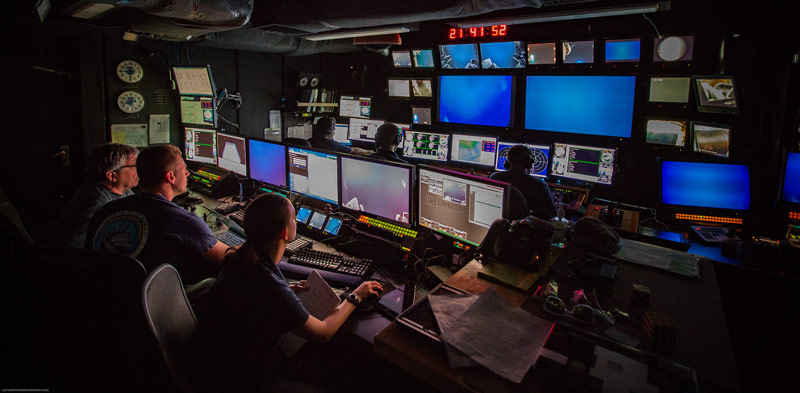
The control room on the Okeanos Explorer during our first dive of the expedition. Image courtesy of the NOAA Office of Ocean Exploration and Research, Deepwater Wonders of Wake. Download larger version (jpg, 2.5 MB).

The control room on the Okeanos Explorer during our first dive of the expedition. Image courtesy of the NOAA Office of Ocean Exploration and Research, Deepwater Wonders of Wake. Download larger version (jpg, 2.5 MB).
Dive 1: Alba Seamount: Giant Anemone
On July 30, 2016, we conducted the first remotely operated vehicle dive of the expedition, exploring a Cretacous-age seamount. This "whopping big" anemone was found and recorded during this dive. The anemone measured 20-30 centimeters (8-12 inches) across and featured tentacles unlike any the science party had seen before. Video courtesy of the NOAA Office of Ocean Exploration and Research, Deepwater Wonders of Wake. Download larger version (mp4, 79.2 MB).
Today we conducted our first remotely operated vehicle (ROV) dive of the cruise at a depth near 2,300 meters. The dive site is the southwest side of Alba Seamount (also reported as Vlinder Seamount). This seamount is a Cretaceous guyot, given its flat top and the radiometric age obtained from a 1980s dredge sample. The dive location focused on one of the volcanic rift zones that emanate from the central guyot platform. At first sight, the bottom consisted of scattered rocks, with light-colored sand. The rocks were thickly coated in manganese (Mn) crust, while the sand appeared mostly white-ish. The sand is likely sourced from the flat platform above, and probably consists of reef debris, mixed with some pelagic sediment. The first rock sample was collected from this area, at the beginning of the dive. As the ROV ascended, the terrain alternated between more broken up Mn-covered rocks with sand and steeper, more massive rocky outcrops that mostly represent Mn-coated pillow and tube structures.
The more massive, rocky areas also served as the more common substrate for the animals that were seen during the dive. The density of the community was sparse to modest, but the diversity was high. The first animals recorded were stalked and unstalked glass sponges, primnoid octocorals, and several shrimp. Other noteworthy biological observations were a tumbling snail and a massive unidentified anemone.
After the ROV was recovered, we started transit mapping to our next dive site, which is nearly 300 nautical miles away. Since it will take us nearly 30 hours to get to the next site, there will be no dive tomorrow.